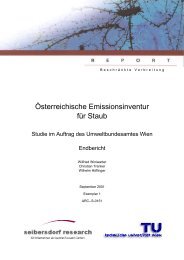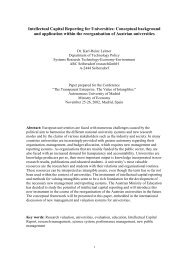ALPMON FINAL REPORT - ARC systems research
ALPMON FINAL REPORT - ARC systems research
ALPMON FINAL REPORT - ARC systems research
Create successful ePaper yourself
Turn your PDF publications into a flip-book with our unique Google optimized e-Paper software.
Contract ENV4-CT96-0359 <strong>ALPMON</strong><br />
information usually available about the atmosphere. Having different measures of the horizontal<br />
visibility within the <strong>research</strong> area at a time before or after satellite image acquisition makes<br />
estimation of a mean value necessary. The result is not very accurate and may cause overcorrection<br />
or under-correction. Over-correction, additionally, results in critical loss of information in<br />
dark areas of the image.<br />
Thus, the result of atmospheric correction is to be seen as very critical. Resulting changes appear to<br />
be not due to real correction but to errors in the correction models. The shortcomings of the available<br />
atmospheric correction algorithms are in our opinion according to the dramatic height differences in all<br />
of the test sites. These are not considered properly in the correction models. In this direction efforts<br />
have to be addressed to the scientific community dealing with atmospheric effects on satellite data<br />
especially in alpine terrain.<br />
Further discussion concerned the order of performing atmospheric correction before or after<br />
topographic normalisation. In general, atmospheric correction is performed on original data, followed<br />
by topographic normalisation. As atmospheric correction may cause information loss mainly within the<br />
lower grey value ranges this becomes a problem for topographic normalisation. This is due to the fact<br />
that diffuse illumination is important for atmospheric correction as well as for topographic<br />
normalisation. Therefore, the opposite order was tested as well. Not being able to solve this problem<br />
by performing the correction in two separate steps, an integrated approach for both correction tasks,<br />
as proposed by Sandmeier and Itten (1997), is strongly recommended. Unfortunately, no such<br />
software is available to the public up to now.<br />
In summary, one can say that from visual interpretation application of the described atmospheric<br />
correction algorithms in general cannot be recommended (also compare section 3.4.2).<br />
3.3.6 Data preparation<br />
3.3.6.1 Data merging<br />
Current remote sensors offer a wide variety of image data with different characteristics in terms of<br />
temporal, geometric, radiometric and spectral resolution. Although the information content of these<br />
images might be partially overlapping, the complementary aspects represent a valuable improvement<br />
for information extraction. To exploit the entire content of multi-sensor image data, appropriate<br />
techniques for image fusion are indispensable. The adaptive image fusion (AIF) method allows the<br />
fusion of geometric (spatial) and thematic (spectral) features from multi-source raster data using<br />
adaptive filter algorithms. If applied to multi-resolution image data, it will sharpen the low spatial<br />
resolution image according to object edges found in the higher spatial resolution image. In contrast to<br />
substitution methods, such as Intensity-Hue-Saturation or Principal-Component Merging, AIF<br />
preserves the spectral characteristics of the original low resolution image.<br />
A major prerequisite for successful data fusion is the geometric and temporal accordance of the input<br />
images. A geometric displacement will lead to undesired artefacts, independent from the fusion<br />
method applied. Differences in the time of data acquisition are another source of artefacts because of<br />
changes that might occur between the two dates. However, these changes are less critical when<br />
applying AIF, as long as they only reflect changes in the spectral characteristic but not in the size of<br />
objects.<br />
Assuming no geometric or temporal variations between the images the quality of the fusion process<br />
depends on the information content of the images. Low quality of the panchromatic data might lead to<br />
poor results because the fusion algorithm will not be able to detect the features necessary for the<br />
merging procedure. However, applying substitution techniques to such a low quality image will not<br />
significantly improve the results either. The major limitation of AIF lies in the loss of local texture that is<br />
present in the panchromatic image. This local variation of grey values cannot be reconstructed in the<br />
multi-spectral image without distorting its spectral characteristic. Only edges that appear clearly in both<br />
images will be sharpened.<br />
The conclusions drawn from the application during the project are manifold. The AIF is considered<br />
useful for areas, that are dominated by objects larger than the low resolution pixel size. Taking the<br />
average pixel size of today’s multi-spectral sensors (20 – 30m) this prerequisite is only true for certain<br />
types of image objects. Due to the size and heterogeneity of the single objects, this does not hold for<br />
forest areas. There the AIF leads to a loss of details caused by averaging the multi-spectral pixels,<br />
which is due to missing information in panchromatic image. However, for the segmentation of forest<br />
and non forest areas the approach is considered valuable. One suggestion might be to use the fusion<br />
JR, RSDE, ALU, LMU, Seibersdorf, WSL 77




